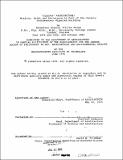"Hideous architecture" : mimicry, feint and resistance in turn of the century southeastern Nigerian building
Author(s)
Okoye, Ikemefuna Stanley Ifejika
DownloadFull printable version (67.32Mb)
Alternative title
Mimicry, feint and resistance in turn of the century southeastern Nigerian building
Terms of use
Metadata
Show full item recordAbstract
This dissertation reconstructs the histories of some exceptional, hitherto unstudied buildings, erected in southeastern Nigeria between 1889 and 1939; they are part of a larger group, dispersed over the African Atlantic coast and 'interior'. To architectural scholarship, these kinds of building have seemed unfathomable , if they emerge at all from invisibility (and thus from being unamenable to study). Typically, they are viewed through a lens which distorts them in one of two mutually complementary ways; one identifies some of them with an extended European architecture. The other consigns the rest a characteristic resistance to change, and situates them within an unhistoricized traditional world. These frames emerge from how the academy views non- western society and from local African representations and feints; both their architecture historical frames tend, then, to frustrate attempts to flee their fields of vision for more clarified accounts. The buildings in this study, and the larger class to which they belong, thus resist an adequately descriptive, coherent, historicized interpretation. Far more than is imagined, textual witness is shown to be available, by 1890, for constructing a part-documentary history that challenges Europeanizing historiographic frames. Moreover oral narratives garnered from the buildings' communities (biographies of builders and of their patrons for whom architecture seems well developed as a form of representation) are founded as this history's necessary and equal complement. Thus, these buildings become recognizable as products of their particular sites (speaking both theoretically and in constructional terms); a recognition encouraged by granting them a categorical distinctiveness that elides, partially, the architecture of the European colony. It will moreover have been shown that transformationality, as opposed to a particular moment of change, was a property of southe~stern Nigerian culture, and that all its customs (and specifically, the latter's architectural tradition) must be regarded as non-stable and eternally reinvented.
Description
Thesis (Ph. D.)--Massachusetts Institute of Technology, Dept. of Architecture and Planning, 1994. Includes bibliographical references (v. 3, leaves 718-730).
Date issued
1994Department
Massachusetts Institute of Technology. Department of Architecture; Massachusetts Institute of Technology. Department of Urban Studies and PlanningPublisher
Massachusetts Institute of Technology
Keywords
Architecture, Urban Studies and Planning